Biography
Research Topics
Antibody Development, Antivirals, Biodefense, Blood-Brain Barrier, Cell Biology, Dendritic Cells, Drug Design and Discovery, Endothelial Cells, Epithelial Cells, Gene Therapy, Gene editing, Glycobiology, HIV/AIDS, Hematopoiesis, Infectious Disease, Interferon, Lung, Lymphocytes, Macrophage, Membranes, Microbiology, Nipah Virus, Nucleus, Paramyxovirus, Protein Trafficking & Sorting, Protein Translation, RNA, RNA Transport & Localization, Retrovirus, Stem Cells, Structural Biology, Systems Biology, Trafficking, Vaccine Development, Viruses and Virology, mRNA Decay
Antibody Development, Antivirals, Biodefense, Blood-Brain Barrier, Cell Biology, Dendritic Cells, Drug Design and Discovery, Endothelial Cells, Epithelial Cells, Gene Therapy, Gene editing, Glycobiology, HIV/AIDS, Hematopoiesis, Infectious Disease, Interferon, Lung, Lymphocytes, Macrophage, Membranes, Microbiology, Nipah Virus, Nucleus, Paramyxovirus, Protein Trafficking & Sorting, Protein Translation, RNA, RNA Transport & Localization, Retrovirus, Stem Cells, Structural Biology, Systems Biology, Trafficking, Vaccine Development, Viruses and Virology, mRNA Decay
Multi-Disciplinary Training Area
Immunology [IMM], Microbiology [MIC]
Immunology [IMM], Microbiology [MIC]
